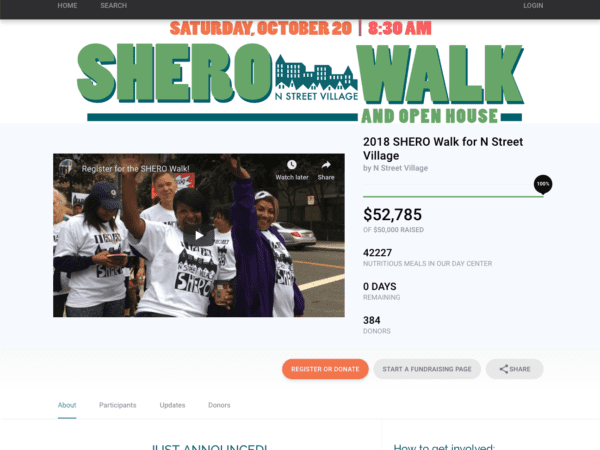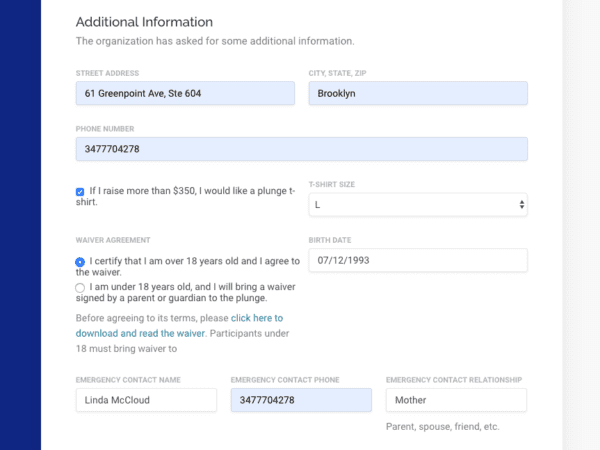Peer-to-peer fundraising isn’t always limited to an online fundraising campaign. Sometimes, nonprofits get creative through peer-to-peer events; effectively raising money and engaging supporters at the same time.
Let’s talk about some of the ways you can use peer-to-peer events to fuel your nonprofit fundraising.
The Lowdown on Peer-to-Peer Events
Peer-to-peer events are a form of peer-to-peer fundraising, a technique that uses the influence of your supporters to raise money for your cause.
Although this type of fundraising historically occurs in-person, technology has enabled nonprofits to bring peer-to-peer online, in a sense broadening a campaign’s exposure.
Peer-to-peer events usually have online and offline components, with fundraisers raising money from friends and family online, followed by an in-person event.
Common peer-to-peer events include:
- Marathons/5Ks/Fun Runs
- DIY events in celebration of a birthday, anniversary, wedding, etc.
- Sport-related activities such as a bowl-a-thon, golf-a-thon, or workout class
- Symbolic gestures and challenges such as a fast or shaving one’s head
Why run a peer-to-peer event?
These fundraisers are so appealing because they don’t just raise money for your organization; they also help you inspire, activate, and rally your supporters to get involved on a deeper level.
Through an event, supporters learn more about your cause, share their knowledge with others, and actively participate to show their commitment.
It’s not uncommon for supporters to get involved with the same peer-to-peer event year after year. Therefore, there seems to be a connection between retention and peer-to-peer events worth exploring.
What’s the first step to getting started?
If you haven’t organized a peer-to-peer event in the best, there’s no time like the present to try it out.
Check out our online guide Peer-to-Peer Fundraising Primer for Nonprofits. Then, follow the nine tips listed below to fine-tune your strategy.
9 Tips for Coordinating a Successful Peer-to-Peer Event From Real Experienced Fundraisers
1. Find the Right Platform
The easiest and most effective way to organize a peer-to-peer event is with an online fundraising platform.
These tools provide a variety of features to help a nonprofit reach an expansive online audience with the help of personal fundraisers. There are standard features to look for when choosing the right platform.
These include:
- Capacity for peer-to-peer and team fundraising
- Personalizable websites
- Custom input fields
- Integrations with other software
- Desktop and mobile-friendly
- Strong customer support
- Adequate space for storytelling
- Cost-effective

Junior Achievement of Greater Washington chose CauseVox to power their large scale peer-to-peer events.
According to Lauren Meltzer, “We needed to find a platform which would be user-friendly, attention-drawing look and feel, and that would help Junior Achievement to maximize our fundraising dollars – all while making each Bowl-a-Thon a successful, fun event for our participants.”
2. Educate Your Fundraisers
Your personal fundraisers (that’s what we call the supporters who actively fundraise online for your cause) are doctors, lawyers, teachers, students, parents, and even sometimes children.
Most of them aren’t trained fundraisers, so it’s vital that your nonprofit provides adequate training and support to guide them on their fundraising journey.
Education comes in many forms. You can create a personal fundraiser toolkit with vital information on the campaign, setting up the fundraising website, and marketing tips.
You can also provide one-on-one training, or designate a support point-person. Any way you cut it, your fundraisers won’t be successful without the right education.

Kelly McLaughlin from the Chesapeake Climate Action Network told us, “I think our main takeaway is that when it comes to [online fundraising], you have two options to expand. You can either recruit more fundraisers, OR you can empower the fundraisers you have to raise more money.”
3. Encourage Storytelling
“People can relate to a story or cause in different ways, so we empower people to share their own story about why they get involved.” Mackenzie Delmotte, N Street Village.

Stories fuel giving. Chances are, your nonprofit has controlled your story narrative for the most part.
You share client testimonials, show inspirational videos, and take pictures from work in the field. But guess what? Your personal fundraisers have stories of their own; stories that relate directly to your organization’s work.
Encourage storytelling by providing sample stories for personal fundraisers to review and give them prompts to help them tell their own. For inspiration, check out: The Ultimate Guide to Storytelling for Personal Fundraisers.
4. Promote the Event Early On
Treat your peer-to-peer event as you would any other fundraising activity.
This means plan and promote ahead of time. Have your website, event details, logistics, personal fundraiser resources ironed out and ready to go 4-6 weeks before kickoff. Recruit your personal fundraisers 2-4 weeks out. And aim to start your campaign with some money in the pot (that’s when donors like your board of directors are key).
Market your event through all your normal channels: email, social media, in-person asks, direct mail, and phone calls– catering your message and request to each segmented supporter. Know who your target personal fundraiser is versus who you think may be a great event sponsor.
“Learn how to get the word out.” Move beyond saying who your organization is and what you do. Instead, cater each message to the recipient,” notes Lauren Melzer Of Junior Achievement of Greater Washington
5. Use Integrations
Nonprofits use a variety of software programs any given day in addition to your online fundraising software. As you’re managing participants, processing donations, and compiling data, remember to use the integrations available through your platform to make your job easier.
For example, CauseVox uses Zapier to streamline processes and improve data collection. CauseVox + Zapier allows nonprofits like Amigos de Las Americas to import vital data from the CauseVox peer-to-peer fundraising platform to over 750 applications.
“The CauseVox integration with Zapier makes this process easy for us on the peer-to-peer side of things. We integrated everything in house and relatively quickly,” said April Hearn of Amigos.
6. Try Custom Fields
Are you providing participants t-shirts? Do you need them to sign a liability waiver? Does your organization prefer to use donation tiers? Custom fields allow your nonprofit to collect the data you need to run your peer-to-peer event seamlessly.

The Chesapeake Climate Action Network relied on CauseVox’s custom fields to capture the information they needed for their annual Polar Bear Plunge event. Some of the fields included t-shirt sizes, waver “signatures,” and contact information. “We learned retroactively that we had to fine-tune our custom fields,” she explained, but she was able to do so effortlessly.
7. Enable the Impact Meter
“People want to see that their donation made an impact for the entire campaign,” said Makenzie Delmotte, Events Manager at N Street Village.

There’s no better way to see the immediate impact of a donation than through an impact meter. These handy tools located directly on your nonprofit and personal fundraisers’ fundraising websites track the campaign’s progress and intended impact in real time. Donors on the fence about giving may be more inclined to give if they see what their gift is poised to do.
8. Replicate from Previous Years (or in the Future)
Once you run one peer-to-peer event, don’t forget to replicate your campaign. This simple set saves you time, and allows you to fine-tune your processes from one event to the next.
“It was easy to replicate our event in the second year, copying most of the content while having the ability to make any needed changes.” David Cohn, First Tee of Southeast Wisconsin.
9. Ask for Help
“Being a fairly complex campaign, the ability to reach the owner to discuss our personal needs, and see them delivered, timely and effectively, has been a major relief on our end,” mentions Lauren Melzer of Junior Achievement of Greater Washington.
As you navigate the world of online peer-to-peer events, remember that we’re here to help.
Typical fundraising software is clunky, complex, and contract-bound, but CauseVox actually tidies up your digital fundraising. Run your peer to peer fundraising event in less time, without hassle.
We’ve put together everything you need to be a fundraising powerhouse — from our award-winning knowledge library to our suite of easy-to-use tools, to our experienced hands-on support team who believe in you and root for you.
Get a demo of CauseVox to see for yourself how you can raise more with less effort.
Editor's Picks
Ultimate Guide To Peer-to-Peer Fundraising
Customer Story: Spur Local Raises Over $1M With Their Give Local Campaign
Fundraising Strategies for Nonprofits: Craft the Best Approach for Your Organization
Create a Killer Fundraising Plan - Best Practices, Strategies, & Downloadable Template



